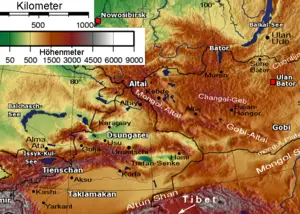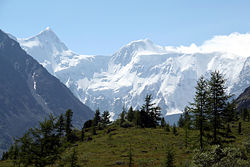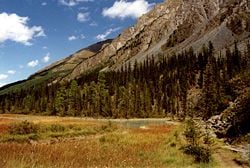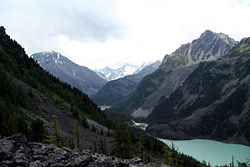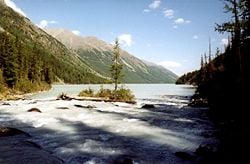Altai Mountains
| Golden Mountains of Altai* | |
|---|---|
| UNESCO World Heritage Site | |
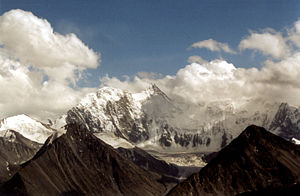
| |
| State Party | |
| Type | Natural |
| Criteria | x |
| Reference | 768 |
| Region** | Europe and North America |
| Inscription history | |
| Inscription | 1998 (22nd Session) |
| * Name as inscribed on World Heritage List. ** Region as classified by UNESCO. | |
The Altay Mountains (Russian: Алтай; Mongolian: Алтай, Altai) are a mountain range in central Asia, where Russia, China, Mongolia and Kazakhstan come together, and where the great rivers Irtysh, Ob and Yenisei have their sources. Altay Mountains are known as the Turkic peoples birthplace. The northwest end of the range is at 52° N and between 84° and 90° E (where it merges with the Sayan Mountains to the east), and extends southeast from there to about , where it gradually becomes lower and merges into the high plateau of the Gobi Desert.
The name, in Turkic Alytau or Altay, means Al (gold), tau (mount); in Mongolian Алтайн нуруу Altain nuruu, the "Mountains of Gold". The proposed Altaic language family takes its name from the mountain range.
Geography
In the north of the region is the Sailughem Mountains, also known as Kolyvan Altai[dubious — see talk page], which stretch northeast from 49° N and 86° E towards the western extremity of the Sayan Mountains in 51° 60' N and 89° E. Their mean elevation is 1,500 to 1,750 m. The snow-line runs at 2,000 m on the northern side and at 2,400 m on the southern, and above it the rugged peaks tower up some 1,000 m more. Mountain passes across the range are few and difficult, the chief being the Ulan-daban at 2,827 m (2,879 m according to Kozlov), and the Chapchan-daban, at 3,217 m, in the south and north respectively. On the east and southeast this range is flanked by the great plateau of Mongolia, the transition being effected gradually by means of several minor plateaus, such as Ukok 2380 m with Pazyryk valley, Chuya 1,830 m, Kendykty 2,500 m, Kak 2,520 m, Suok 2,590 m, and Juvlu-kul 2,410 m.
This region is studded with large lakes, e.g. Uvs Nuur 720 m above sea level, Kirghiz-nor, Durga-nor and Khovd Nuur 1,170 m, and traversed by various mountain ranges, of which the principal are the Tannu-Ola Mountains, running roughly parallel with the Sayan Mountains as far east as the Kosso-gol, and the Khan-khu Mountains, also stretching west and east.
The north-western and northern slopes of the Sailughem Mountains are extremely steep and difficult to access. On this side lies the highest summit of the range, the double-headed Belukha, whose summits reach 4,506 and 4,440 m respectively, and give origin to several glaciers (30 square kilometeres in aggregate area, as of 1911). Here also are the Kuitun (3,660 m) and several other lofty peaks. Numerous spurs, striking in all directions from the Sailughem mountains, fill up the space between that range and the lowlands of Tomsk. Such are the Chuya Alps, having an average altitude of 2,700 m, with summits from 3,500 to 3,700 m, and at least ten glaciers on their northern slope; the Katun Alps, which have a mean elevation of about 3,000 m and are mostly snow-clad; the Kholzun range; the Korgon 1,900 to 2,300 m, Talitskand Selitsk ranges; the Tigeretsk Alps, .
Several secondary plateaus of lower altitude are also distinguished by geographers, The Katun valley begins as a wild gorge on the south-west slope of Belukha; then, after a big bend, the river (600 km long) pierces the Katun Alps, and enters a wider valley, lying at an altitude of from 600 to 1,100 m, which it follows until it emerges from the Altai highlands to join the Biya in a most picturesque region. The Katun and the Biya together form the Ob.
The next valley is that of the Charysh, which has the Korgon and Tigeretsk Alps on one side and the Talitsk and Bashalatsk Alps on the other. This, too, is very fertile. The Altai, seen from this valley, presents the most romantic scenes, including the small but deep Kolyvan lake (altitude 360 m), which is surrounded by fantastic granite domes and towers.
Farther west the valleys of the Uba, the Ulba and the Bukhtarma open south-westwards towards the Irtysh. The lower part of the first, like the lower valley of the Charysh, is thickly populated; in the valley of the Ulba is the Riddersk mine, at the foot of the Ivanovsk Peak (2,060 m), clothed with alpine meadows. The valley of the Bukhtarma, which has a length of 320 km, also has its origin at the foot of the Belukha and the Kuitun peaks, and as it falls some 1,500 m in about 300 km, from an alpine plateau at an elevation of 1,900 m to the Bukhtarma fortress (345 m), it offers the most striking contrasts of landscape and vegetation. Its upper parts abound in glaciers, the best known of which is the Berel, which comes down from the Byelukha. On the northern side of the range which separates the upper Bukhtarma from the upper Katun is the Katun glacier, which after two ice-falls widens out to 700 to 900 metres. From a grotto in this glacier bursts tumultuously the Katun river.
The middle and lower parts of the Bukhtarma valley have been colonized since the 18th century by runaway Russian peasants, serfs and religious schismatics (Raskolniks), who created a free republic there on Chinese territory; and after this part of the valley was annexed to Russia in 1869, it was rapidly colonized. The high valleys farther north, on the same western face of the Sailughem range, are but little known, their only visitors being Kirghiz shepherds.
Those of Bashkaus, Chulyshman, and Chulcha, all three leading to the alpine lake of Teletskoye (length, 80 km; maximum width, 5 km; altitude, 520 m; area, 230.8 square kilometeres; maximum depth, 310 m; mean depth, 200 m), are inhabited by Telengit people. The shores of the lake rise almost sheer to over 1,800 m. From this lake issues the Biya, which joins the Katun at Biysk, and then meanders through the prairies of the north-west of the Altai.
Farther north the Altai highlands are continued in the Kuznetsk district, which has a slightly different geological aspect, but still belongs to the Altai system. But the Abakan river, which rises on the western shoulder of the Sayan mountains, belongs to the system of the Yenisei. The Kuznetsk Ala-tau range, on the left bank of the Abakan, runs north-east into the government of Yeniseisk, while a complexus of mountains (Chukchut, Salair, Abakan) fills up the country northwards towards the Trans-Siberian railway and westwards towards the Ob.
The Ek-tagh or Mongolian Altai, which separates the Khovd basin on the north from the Irtysh basin on the south, is a true border-range, in that it rises in a steep and lofty escarpment from the Dzungarian depression (470-900 m), but descends on the north by a relatively short slope to the plateau (1,150 to 1,680 m) of north-western Mongolia. East of 94° E the range is continued by a double series of mountain chains, all of which exhibit less sharply marked orographical features and are at considerably lower elevations. The slopes of the constituent chains of the system are inhabited principally by nomad Kirghiz.
World Heritage site
A vast area of 16,175 km² - Altai and Katun Natural Reserves, Lake Teletskoye, Mount Belukha and the Ukok Plateau - comprise a natural UNESCO World Heritage Site entitled Golden Mountains of Altai. As stated in the UNESCO description of the site, "the region represents the most complete sequence of altitudinal vegetation zones in central Siberia, from steppe, forest-steppe, mixed forest, subalpine vegetation to alpine vegetation". While making its decision, UNESCO also cited Russian Altai's importance for preservation of the globally endangered mammals, such as snow leopard and the Altai argali.[1]
Geology
The Siberian Altai represents the northern most region affected by the tectonic collision of India into Asia. Massive fault systems run through the area, including the Kurai fault zone and the recently identified Tashanta fault zone. These fault systems are typically thrusts or right lateral strike-slip faults, some of which are tectonically active. Rock types in the mountains are typically granites and metamorphic schists, and some are highly sheared near to fault zones.
Seismic activity
On 27th September 2003 a massive earthquake, measuring MW 7.3, occurred in the Chuya Basin area to the south of the Altai region. Seismic activity is however a rare occurrence. This earthquake and its aftershocks devastated much of the region, causing $10.6 million in damage (USGS) and wiping out the village of Beltir.
See also
- Altai Krai
- Altaic languages
- Altay language
Notes
- ↑ Greater Altai – Altai Krai, Republic of Altai, Tyva (Tuva), and Novosibirsk - Crossroads. Retrieved 2006-11-30.
ReferencesISBN links support NWE through referral fees
- This article incorporates text from the Encyclopædia Britannica Eleventh Edition, a publication now in the public domain.
External links
- Altai-Project of the Technical University of Dresden - Institute of Cartography
- 24-days in Altai - A travel account from the south of Altai.
- UNESCO's evaluation of Altai (PDF file)
| |||||||
be:Алтай bg:Алтай ca:Massís de l'Altai cs:Altaj (pohoří) da:Altai de:Altai (Gebirge) et:Altai es:Macizo de Altai eo:Altajo fr:Altaï ko:알타이 산맥 it:Altai (monti) la:Altai lt:Altajaus kalnai nl:Altaj (gebergte) ja:アルタイ山脈 pl:Ałtaj ro:Munţii Altai ru:Алтайские горы sl:Altaj fi:Altai (vuoristo) sv:Altaj th:เทือกเขาอัลไต vi:Dãy núi Altay tr:Altay dağları uk:Алтай (гори) zh:阿尔泰山脉
Credits
New World Encyclopedia writers and editors rewrote and completed the Wikipedia article in accordance with New World Encyclopedia standards. This article abides by terms of the Creative Commons CC-by-sa 3.0 License (CC-by-sa), which may be used and disseminated with proper attribution. Credit is due under the terms of this license that can reference both the New World Encyclopedia contributors and the selfless volunteer contributors of the Wikimedia Foundation. To cite this article click here for a list of acceptable citing formats.The history of earlier contributions by wikipedians is accessible to researchers here:
The history of this article since it was imported to New World Encyclopedia:
Note: Some restrictions may apply to use of individual images which are separately licensed.
